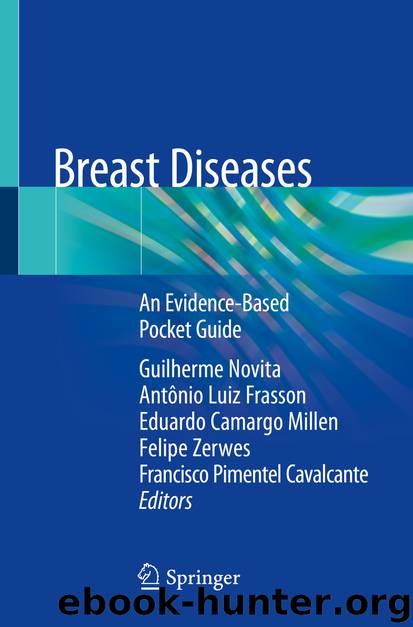Breast Diseases by Unknown

Author:Unknown
Language: eng
Format: epub
ISBN: 9783030136369
Publisher: Springer International Publishing
Influence on Oncologic Treatment
The basilar study that established OP draws attention not only to its cosmetic benefits, but mainly to the surgical margins in this procedure. At the Institute Curie, Paris, Clough et al. [1] studied 101 patients operated by means of OP techniques between 1985 and 1999. The average tumor-resected breast tissue weight was 222 g (four times as much as in a classic quadrantectomy). In 90 patients, the margins were free, and in 11 patients they were positive. The mean follow-up was 3.8 years and the local recurrence rate was 9.4%. Overall survival in this group of patients was 95.7% and metastasis-free survival was 82.8%. Aesthetic results were considered favorable in most cases. The study was able to bring important elements for discussion in the scientific community and proved the capacity of this type of surgery to allow more extensive breast resections.
Two other studies at the European Institute of Oncology in Milan have demonstrated the oncological safety of OP. The first one, a prospective study, compared the quadrantectomy margins with the OP margins and found a higher negative margin index in OP, thus confirming previous data in non-comparative studies. The second one, a retrospective cohort, sought to assess late oncologic outcomes. In the period between 1994 and 1999, 148 patients with tumors T1 to T3 underwent this type of surgery. The mean follow-up of these patients was 74 months and showed a lower-than-expected local recurrence rate in conventional CS. There was no local recurrence in patients in the carcinoma in situ and the pT1 carcinoma groups. Recent meta-analysis also showed lower rates of reoperation with OP compared to BCS.
There are well-established indications for OP in BCS. The main one is for patients with gigantism, where the results of mastectomy with preservation of the skin or the NAC are usually unsatisfactory and the OP can also favor radiotherapeutic planning.
Therefore, besides allowing for aesthetic improvement, OP can also reduce reoperations with damaged margins in the BCS. Breast reduction also improves local conditions for radiotherapy planning in bulky breasts, or it even allows BCS in patients with small breasts or in cases of tumors located in regions at risk for obtaining a satisfactory aesthetic result and in multifocal and multicentric tumors. This advance definitively modified the view that the concern with aesthetics could impair the oncological result, or vice- versa. And with that, the a esthetic results in both BCS and mastectomy have improved significantly in recent years.
Download
This site does not store any files on its server. We only index and link to content provided by other sites. Please contact the content providers to delete copyright contents if any and email us, we'll remove relevant links or contents immediately.
Adulting by Kelly Williams Brown(3678)
Figure Drawing for Artists by Steve Huston(2804)
Draw Your Day by Samantha Dion Baker(2713)
Drawing Cutting Edge Anatomy by Christopher Hart(2682)
Drawing Shortcuts: Developing Quick Drawing Skills Using Today's Technology by Leggitt Jim(2534)
Make Comics Like the Pros by Greg Pak(2427)
Draw to Win: A Crash Course on How to Lead, Sell, and Innovate With Your Visual Mind by Dan Roam(2278)
How Proust Can Change Your Life by Alain De Botton(2265)
Day by Elie Wiesel(2247)
0041152001443424520 .pdf by Unknown(2228)
How The Mind Works by Steven Pinker(2221)
Rapid Viz: A New Method for the Rapid Visualization of Ideas by Kurt Hanks & Larry Belliston(2200)
Modern Cartooning by Christopher Hart(2192)
Poses for Artists Volume 2 - Standing Poses: An essential reference for figure drawing and the human form. (Inspiring Art and Artists) by Justin Martin(2148)
Draw-A-Saurus by James Silvani(2108)
Learn Drawing Quickly by Sharon Finmark(2095)
Tattoo Art by Doralba Picerno(2085)
Poses for Artists - Dynamic & Sitting: An essential reference for figure drawing and the human form (Inspiring Art and Artists Book 1) by Justin R Martin(2065)
Drawing and Painting Birds by Tim Wootton(2005)
